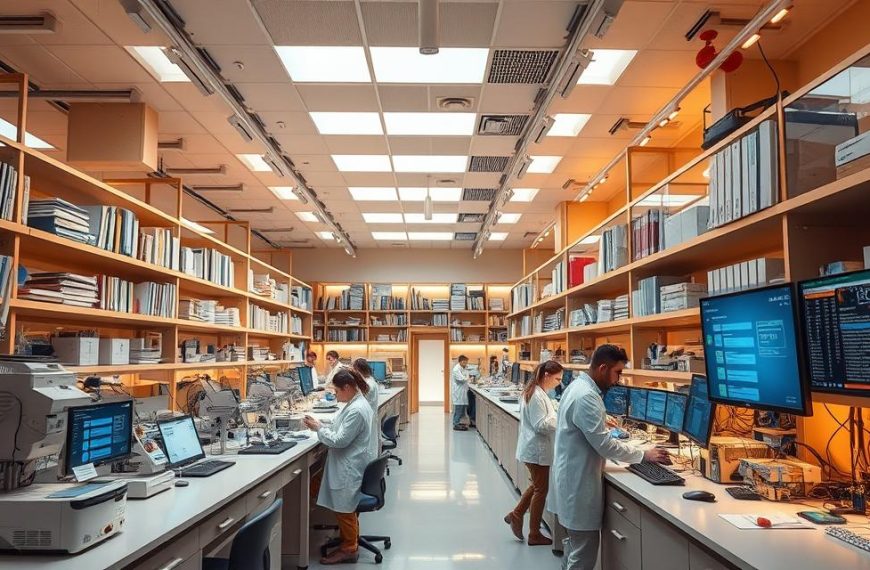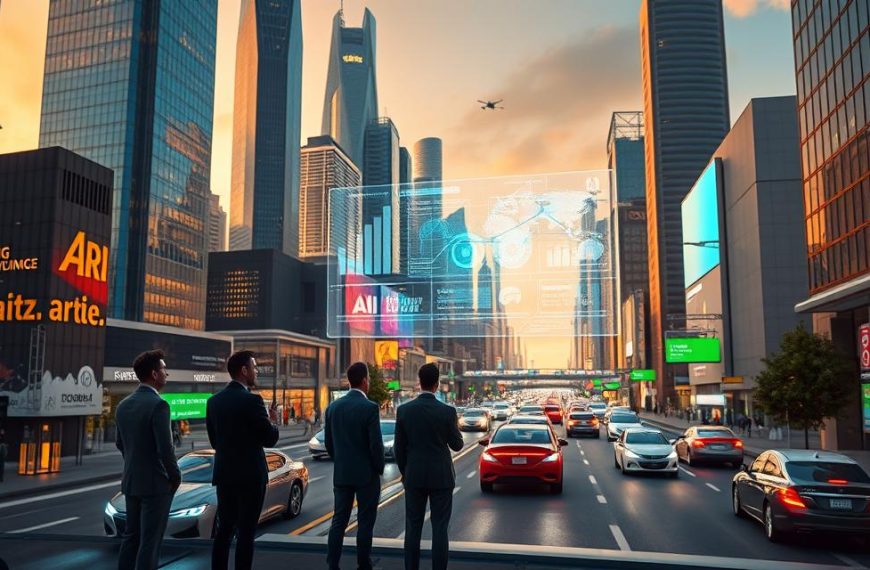In today’s fast-paced world, a new type of company is leading the way. They use breakthrough technologies to solve big problems that old ways can’t tackle. Their work, from quantum computing to synthetic biology, is key to the fourth wave of industrial innovation.
A BCG framework sees these companies as the next step after digital transformation. They focus on solving big problems with next-gen startups that combine hardware, software, and research. Their projects, like carbon capture and neural interfaces, take years but could change everything.
What makes these companies special? They aim for lasting changes, not just quick growth. Now, venture capital gives 25% more money to these projects than in 2020. They see the chance to change healthcare, energy, and manufacturing. These innovators help old industries meet their green goals.
Defining the Deep Tech Revolution
The deep tech revolution is changing how we innovate. It combines advanced science with real-world problems. Unlike regular startups, these ventures aim to solve big problems with scientific breakthroughs.
Boston Consulting Group’s Pasteur’s Quadrant framework shows this approach. It focuses on research that is both ambitious and practical.
What Sets Deep Tech Apart?
Deep tech companies are different from traditional tech startups. They start working on solutions years before they are needed. This requires patience and a lot of money to fund their research and development.
Core characteristics differentiating deep tech from conventional startups
There are three key things that make deep tech unique:
- Problem-first orientation: 96% of deep tech projects aim to solve global challenges using new technologies
- Hardware integration: 83% of deep tech involves creating physical products, combining digital and material science
- Long development horizons: Solutions can take 5-10 years to become commercially viable
Key Innovation Drivers
Recent breakthroughs in various fields have opened up new opportunities for deep tech. These advancements are making progress faster than we thought possible just a decade ago.
Breakthroughs in AI, quantum computing and material science enabling progress
Three key areas are driving this revolution:
- AI breakthroughs: Machine learning systems like AlphaFold have solved protein-folding puzzles that baffled scientists for decades
- Quantum advancements: Companies like Rigetti Computing have achieved quantum supremacy milestones 3x faster than expected
- Material innovations: Graphene production costs have dropped 80% in five years, making it ready for commercial use
“We’re witnessing the fourth industrial revolution – where digital, physical and biological systems converge to solve problems we once considered intractable.”
These advancements are backed by new platform technologies. They cut prototyping costs by up to 70%, according to recent studies. This has led to a new wave of startups turning ambitious ideas into real products.
Companies Leading the Deep Tech Innovation Wave
A new wave of tech firms is changing what’s possible. They use the design-build-test-learn (DBTL) cycle to speed up innovation. This is like Commonwealth Fusion Systems’ fast track to fusion energy.
Quantum Computing Trailblazers
Rigetti Computing shows how hybrid quantum-classical systems can solve today’s problems. They mix supercomputers with quantum processors for better financial and drug discovery models.
Rigetti Computing’s hybrid quantum-classical systems
Their 80-qubit Aspen-M processor lets businesses test quantum algorithms safely. This step helps make quantum tech practical.
D-Wave Systems’ quantum annealing applications
D-Wave’s quantum annealing applications are changing logistics for companies like Volkswagen. Their systems are 100x faster than classical computers in solving route optimisation tasks.
Biotech Visionaries
Biology and AI are leading to big medical breakthroughs. BCG found companies using DBTL cycles innovate 40% faster than usual.
CRISPR Therapeutics’ gene-editing advancements
CRISPR Therapeutics’ CTX001 therapy for blood disorders is a big win. It’s the first CRISPR treatment approved in Europe. Their method makes DNA changes more precisely than before.
Insilico Medicine’s AI-driven drug discovery
Insilico Medicine uses AI and quantum computing to speed up drug discovery. They’ve cut drug discovery time from 5 years to under 18 months. Their AI drug discovery found a new fibrosis treatment target in just 46 days.
Space Technology Pioneers
As space gets busier, new solutions are needed. These companies are leading with innovative engineering and sustainable practices.
Rocket Lab’s satellite deployment solutions
The Electron rocket’s 45th launch in May 2024 showed its reliability in satellite deployment tech. Rocket Lab’s Photon spacecraft supports missions from Earth observation to interplanetary exploration.
Astroscale’s orbital debris management systems
Astroscale’s ELSA-M servicer is a game-changer. It captures defunct satellites using magnetic docking. This is key for keeping space safe.
Overcoming Deep Tech Commercialisation Challenges
Turning deep tech innovations into market-ready solutions is tough. It involves financial, talent, and regulatory hurdles. Despite reaching $60 billion in global investments by 2020, scaling these technologies is complex.
Funding Complex Research Projects
Deep tech ventures often take a decade to develop. This scares off traditional investors. BCG says only 20% of early-stage projects get Series B funding due to high risks and delayed returns.
Strategies for Securing Long-Term Investment Cycles
- Leverage blended finance models: Mix venture capital with government grants or corporate R&D partnerships to reduce risks.
- Adopt milestone-based funding: Make agreements based on technical validation points to keep investors confident.
- Target specialist funds: Work with deep tech venture capitalists who get extended timelines, as Hello Tomorrow’s analysis shows.
Bridging the Talent Gap
Creating teams for quantum computing or synthetic biology is hard. A 2023 survey found 73% of deep tech founders struggle to find the right talent.
Approaches to Recruiting Multidisciplinary Teams
- Partner with academic institutions to find emerging researchers
- Create hybrid roles that mix technical and commercial skills
- Use equity-sharing schemes to compete with big tech salaries
Navigating Regulatory Landscapes
Regulations struggle to keep up with tech advances. From medical AI to drones, it’s a challenge. Moderna’s COVID-19 vaccine shows how to succeed, getting approval in 11 months.
Case Studies in Medical AI and Autonomous Systems Approval
- Engage with agencies early in development
- Use modular trial designs for quick data submission
- Form public-private safety consortiums for autonomous vehicles
These strategies show how to align innovation with regulations. This can speed up commercialisation while keeping standards high.
The Investor Landscape for Disruptive Technologies
Deep tech innovation has changed how funding works around the world. Investors now mix high-risk investments with patience. This creates a new way of funding: venture capital, public support, and working with big companies.
Venture Capital Trends
Sequoia Capital’s deep tech investment thesis focuses on big bets with a 10-year view. They’ve set up a $600m fund for startups in quantum-resistant cryptography and fusion energy. They believe in “fundamental physics breakthroughs driving the next compute paradigm”.
DCVC’s machine learning focus shows in real-world uses. Scale AI, a company in their portfolio, used reinforcement learning to improve port logistics. This cut cargo handling costs by 37% in tests.
“We’re seeing AI move from pattern recognition to actual causation modelling – that’s when real-world impact happens.”
Government-Backed Initiatives
Public sector programmes help with risky technologies that private markets can’t handle:
- DARPA’s AI Next campaign gave $2bn to over 60 projects. This included neural interface prototypes that worked 90% accurately in human tests.
- European Innovation Council used a mix of finance to support 4,000 startups. They combined €2.4bn in grants with equity investments.
Corporate Partnership Models
Big companies are teaming up more:
| Initiative | Focus Area | Outcome |
|---|---|---|
| Google X Moonshot Factory | Hyperscale computing | 17 commercial spinouts in 2020 |
| Siemens Accelerator | Industrial IoT | 83% of participants survived after the programme |
BCG data shows big companies got more involved in deep tech from 2019-2023. They now focus on joint development agreements.
Emerging Technologies Shaping Tomorrow
Artificial intelligence gets a lot of attention, but three new technologies are changing the game in computing, energy, and biology. These innovations have been in the making for decades. They are now ready to make a big impact by solving long-standing problems in new ways.
Neuromorphic Computing Breakthroughs
Traditional computers struggle with tasks that come easily to humans, like recognizing patterns. Neuromorphic computing uses artificial neural networks to solve these problems. Intel’s Loihi 2 chip is a great example, with 1 million artificial neurons that learn and adapt quickly.
Intel’s Loihi 2 Neuromorphic Chip Architecture
The Loihi 2 chip works differently than usual computers. It uses “spikes” to process data, not a fixed clock cycle. This makes machine learning 40% faster and uses 90% less power. Experts think this could save £18 billion in energy costs by 2030.
Advanced Nuclear Solutions
As the world faces climate challenges, fusion energy is being developed to harness star power. Fusion energy produces very little waste, which is a big plus for public acceptance.
Commonwealth Fusion Systems’ SPARC Reactor Project
Bill Gates and Google are backing CFS to make fusion energy a reality by 2025. Their technology uses high-temperature superconductors to make reactors smaller. Fusion is seen as a critical technology, but it’s not getting enough funding.
Synthetic Biology Innovations
Synthetic biology is taking gene editing to the next level. It treats DNA as software, allowing for the creation of new organisms. These organisms can make everything from spider silk to fuels that don’t harm the environment.
Ginkgo Bioworks’ Organism Design Platform
Ginkgo Bioworks in Boston is leading the way in synthetic biology. They test 50,000 genetic variations every week. This is faster than traditional labs. They’ve also created microbes that can break down plastic waste. “We’re not just reading nature’s code anymore – we’re compiling new operating systems for life itself,” says CEO Jason Kelly.
Global Impact of Deep Tech Advancements
Deep tech innovations are changing old industries and solving big problems. BCG’s model shows how these breakthroughs affect many areas. They show up in three key ways.
Transforming Traditional Industries
Energy giants like BP are changing with new tech. They use machine learning to explore for oil. This has made a big difference.
- Reduces exploration time by 60% compared to traditional methods
- Identifies drilling sites with 90% greater accuracy
- Cuts operational costs by £140 million annually
BP now spends 15% of its R&D budget on renewable energy. This is a big change.
BP’s machine learning applications in energy exploration
The company’s ‘Sandy’ AI platform works with huge amounts of data. It helps make better drilling decisions. This has made oil extraction more efficient and cut down on pollution.
Addressing Climate Challenges
Companies like Carbon Engineering are finding new ways to tackle climate change. Their technology captures CO2 directly from the air. It’s a game-changer.
| Metric | Traditional CCS | Direct Air Capture |
|---|---|---|
| CO2 Capture Rate | 85-90% | 100% atmospheric |
| Location Flexibility | Limited to emission sources | Anywhere |
| Cost per Ton (2024) | £45-£60 | £75-£95 |
This technology is more expensive now. But it’s key for reaching net-zero goals.
Carbon Engineering’s direct air capture technology
Their Texas plant removes 500,000 tonnes of CO2 every year. That’s like taking 110,000 cars off the road. They’re working with Occidental Petroleum to do even more by 2030.
Revolutionising Healthcare Delivery
Oxford Nanopore’s small sequencers are changing healthcare. They can:
- Ebola strain identification in 6 hours (vs 3 weeks previously)
- Real-time COVID variant tracking across 85 countries
- Rural cancer diagnostics without lab infrastructure
Oxford Nanopore’s portable DNA sequencing devices
Their MinION Mk1C device helped in Uganda’s 2022 Marburg outbreak. It found the virus 73% faster than before. Now, over 75,000 units are used worldwide.
Conclusion
The deep tech future comes from working together in science, business, and policy. Boston Consulting Group’s innovation wave theory shows key moments, from starting research to making it big. Companies like IBM Quantum and SpaceX show how breakthroughs work when they meet market needs and rules.
Investments show what’s important in the innovation world. Money going into CRISPR therapies and modular nuclear reactors shows faith in solving big problems. Governments help by starting programs like the EU Quantum Flagship Programme, making it easier for new tech to grow.
Success needs both big dreams and doing things right. Moderna’s mRNA work shows how to make biotech work in the real world. Startups like PsiQuantum are tackling quantum engineering with help from universities. Everyone must focus on long-term research and training to keep moving forward.
As synthetic biology changes how we make things and neuromorphic computing changes AI, we need to be careful. The next ten years will be a test of how well we use new tech. Working together is not just good; it’s essential for making a real difference worldwide.

















